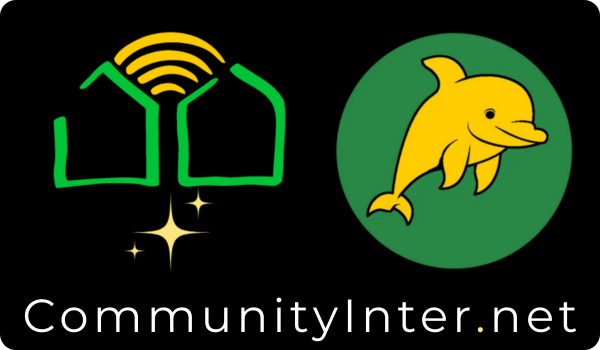Internet Access Peering Improves Housing Affordability

The policy implications of peering for housing providers—especially those involved in affordable housing—are increasingly significant as broadband becomes essential infrastructure. Here’s how peering impacts housing policy and what providers and municipalities should consider:
1. Treat Broadband as Critical Utility Infrastructure
Peering arrangements improve affordability and reliability of internet service. When housing providers partner with ISPs that peer locally (e.g., via an Internet Exchange Point or IXP), residents can benefit from:
- Lower latency
- Faster speeds
- More stable connections
Implication: Housing policy should support or require broadband-ready construction and promote partnerships with ISPs engaged in local peering to maximize service quality at lower cost.
2. Use Public Leverage to Attract Peered ISPs
Cities or housing authorities often control rights-of-way, rooftops, and conduit access. These assets can be offered to locally peered ISPs in exchange for:
- Discounted or free service for low-income residents
- Open-access fiber infrastructure in new housing developments
Implication: Public land-use and permitting policies can be structured to incentivize ISP peering and discourage monopoly arrangements in housing developments.
3. Reduce Costs with Aggregated Bandwidth and Peering
In multi-dwelling units (MDUs), housing providers can bulk-purchase bandwidth and either:
- Resell it to tenants (at-cost or subsidized)
- Provide free in-building Wi-Fi
When providers peer at an IXP, costs drop because data is exchanged directly instead of routed via expensive transit paths.
Implication: Public funding (e.g., HUD, ARPA, IIJA) can be used to support MDU-scale broadband systems that take advantage of peering to reduce long-term operating costs.
4. Build Housing Near Digital Infrastructure Hubs
IXPs and fiber hubs are emerging as critical infrastructure similar to transit stations. Locating affordable housing near them enables:
- Cheaper broadband buildouts
- Job access in the tech sector
- Integration with smart city networks
Implication: Planning and zoning policies should identify and preserve land near IXPs for digitally connected housing, particularly for workforce and low-income residents.
5. Encourage Municipal and Cooperative Peering Models
Community-owned broadband or cooperative ISPs can peer at local IXPs to lower costs and reinvest savings in:
- Tenant digital literacy programs
- Device lending
- Subsidized service tiers
Implication: Housing policy can encourage nonprofit broadband cooperatives that prioritize affordability and digital equity through peering.
Summary of Actions for Policymakers:
- Incentivize ISPs with local peering through development deals.
- Require open-access, broadband-ready wiring in all new housing.
- Use public land or rooftops to support peered network infrastructure.
- Direct public funds toward infrastructure projects that reduce cost via peering.
- Support community-based ISPs that peer and serve low-income buildings.
Here’s how the policy implications of peering can be translated into municipal zoning code language and funding program criteria for affordable housing initiatives:
🏙️
Model Zoning Code Language for Broadband & Peering
Section XX.XX: Digital Infrastructure Standards for Multi-Dwelling Units
A. Broadband-Ready Requirements
- All new residential developments with five or more units shall:
- Include structured wiring (Cat6 or better) to each unit.
- Provide common-area access points for building-wide Wi-Fi.
- Designate space in utility rooms for future networking hardware.
B. Internet Exchange Point (IXP) Compatibility
2. Developments within 5 miles of a recognized IXP shall:
- Provide conduit or rooftop access to facilitate direct connection to ISPs that peer at the IXP.
- Give priority leasing opportunities to ISPs participating in local peering agreements.
C. Open-Access Provision
3. Landlords or housing developers shall not enter into exclusive ISP agreements that restrict tenant access to alternative broadband providers.
- Buildings shall support multiple ISPs with non-discriminatory access to in-building wiring.
D. Incentives
4. Projects that provide in-building internet service via a provider that peers at a local IXP may receive:
- Up to 20% density bonuses.
- Reduced permit fees.
- Fast-track permitting eligibility.
💰
Funding Program Criteria: Broadband & Peering Addendum
This can be added to state or local affordable housing trust fund programs, ARPA disbursement programs, or municipal housing incentives.
Eligibility Criteria for Broadband Infrastructure Grants in Housing
Projects may apply for broadband infrastructure support funding if they meet all of the following criteria:
1. Infrastructure Readiness
- The project includes plans for broadband wiring compliant with IXP-ready standards (e.g., in-unit Cat6, central conduit to MDF).
- Network infrastructure is open-access and permits multiple ISPs to connect.
2. Peering-Driven Cost Reduction
- The internet provider connected to the development is a participant in a recognized Internet Exchange Point (IXP) within 100 miles.
- Applicant provides documentation of peering agreements or a letter of commitment from a participating ISP.
3. Affordability Metrics
- Internet service offered to tenants must include at least one plan priced below $30/month for symmetrical speeds of 100 Mbps or greater.
- Free Wi-Fi in common areas must be available to all tenants.
4. Equity and Inclusion
- Priority consideration will be given to projects in census tracts where:
- More than 25% of residents lack home broadband.
- At least 50% of households earn below 60% AMI.
For your city council
Here’s a draft city council policy resolution adapted from the peering-focused broadband and housing criteria:
City Council Resolution No. [2025-XXX]
Title: A Resolution to Promote Digital Equity by Integrating Peering-Based Broadband Infrastructure in Affordable Housing Developments
WHEREAS, equitable access to high-speed internet is essential for education, employment, healthcare, and civic participation; and
WHEREAS, the lack of affordable, reliable broadband is a significant barrier to opportunity for low- and moderate-income households, especially in multi-dwelling residential developments; and
WHEREAS, Internet Exchange Points (IXPs) provide critical infrastructure that reduces latency, improves reliability, and lowers broadband costs by enabling direct peering between networks; and
WHEREAS, locally peered networks represent a cost-effective solution to address the digital divide in affordable housing; and
WHEREAS, municipalities have the ability and obligation to ensure that publicly supported housing investments include digital infrastructure that meets the needs of 21st-century residents;
NOW, THEREFORE, BE IT RESOLVED THAT the City Council of [City Name], [State], adopts the following policy framework to guide the integration of broadband infrastructure into affordable housing development:
Section 1: Broadband Infrastructure Standards
- All new multi-dwelling housing developments receiving city funding, zoning variances, or land contributions shall:
- Include structured wiring to all units (Cat6 or better).
- Support building-wide Wi-Fi access points in common areas.
- Provide accessible space for network distribution equipment.
Section 2: Preference for Peering-Based ISPs
- Projects shall give priority to internet service providers that:
- Participate in a recognized Internet Exchange Point (IXP) within 100 miles of the project site.
- Demonstrate local peering relationships that reduce transit dependency and support open-access networks.
Section 3: Open-Access and Non-Exclusivity
- Housing developers shall not enter exclusive arrangements with broadband providers that restrict tenant access to alternative ISPs. All in-building wiring must be made available to multiple service providers on fair and reasonable terms.
Section 4: Tenant Affordability Requirements
- At least one internet service plan must be available to tenants at a minimum of 100 Mbps symmetrical speed and priced below $30/month. Free common-area Wi-Fi shall be provided in all city-supported buildings.
Section 5: Incentives and Funding Prioritization
- Projects meeting these standards shall be eligible for:
- Fast-track permitting.
- Density bonuses of up to 20%.
- Priority access to housing infrastructure grants, trust fund dollars, or American Rescue Plan Act allocations designated for digital inclusion.
Section 6: Implementation and Monitoring
- The [City’s Office of Housing and Community Development] and [IT Department or Broadband Office] shall:
- Develop application guidelines and review criteria for developers.
- Maintain a list of eligible IXPs and peering-qualified ISPs.
- Report annually to City Council on broadband coverage, cost savings, and resident adoption in covered developments.
PASSED AND APPROVED THIS ___ day of ________, 2025.
[Mayor Name]
Mayor, City of [City Name]
[City Clerk Name]
City Clerk
Slides to present to municipal leaders
Here is a full slide-by-slide PowerPoint outline for a City Council briefing aimed at encouraging support for a resolution to promote Internet peering and digital infrastructure in affordable housing:
Slide 1: Title Slide
Text:
- Title: Promoting Digital Equity in Affordable Housing
- Subtitle: Briefing for City Council Members
- Date: March 2025
Layout:
- Centered text, clean blue background.
Visuals:
- City logo (bottom corner)
- Background pattern of housing units or a digital grid.
Slide 2: Why This Matters
Text:
- 29 million U.S. households lack high-speed internet.
- In affordable housing, residents face barriers of cost, choice, and quality.
- Internet access is essential for education, employment, healthcare, and civic participation.
Layout:
- 3 bullet points, left-aligned.
Visuals:
- Icons: graduation cap, stethoscope, laptop, housing.
Slide 3: What is Peering and Why It Helps
Text:
- Peering = direct data exchange between networks.
- Reduces cost, improves speed and reliability.
- Local peering keeps traffic local, avoids monopoly tolls.
Layout:
- Left: bullet points. Right: simple diagram.
Visuals:
- [Insert peering diagram you created earlier.]
Slide 4: Current Challenges in Housing
Text:
- Many affordable units lack building-wide internet or offer only one provider.
- Residents pay high prices for poor connections.
- Exclusive ISP deals limit competition and affordability.
Layout:
- 2 columns: Challenges | Resident Impact.
Visuals:
- Photo of an MDU building or a screenshot of a $90 internet bill.
Slide 5: Policy Opportunity
Text:
- Use zoning, permitting, and funding tools to:
- Require broadband-ready wiring.
- Prioritize ISPs with local peering agreements.
- Prohibit exclusive ISP deals in city-supported housing.
Layout:
- Checklists or 3-column grid.
Visuals:
- Icons: Ethernet port, handshake, zoning map.
Slide 6: Proposed Resolution Summary
Text:
- Adopt resolution requiring:
- Open-access, peering-preferred broadband in new affordable housing.
- Affordability thresholds (e.g., $30/month for 100 Mbps).
- In-building infrastructure standards (Cat6, Wi-Fi in common areas).
Layout:
- Numbered list format.
Visuals:
- Policy document graphic with checkmarks.
Slide 7: Benefits to the City
Text:
- Promotes equity, workforce readiness, digital inclusion.
- Attracts competitive ISPs and tech jobs.
- Leverages ARPA and federal broadband funding.
Layout:
- 3 key benefit blocks.
Visuals:
- Green “win-win” arrows pointing toward community and city icons.
Slide 8: Case Study – Oakland, CA
Text:
- Over 14,000 residents connected via free apartment Wi-Fi.
- Peering-enabled ISPs deliver faster service at lower cost.
- Landlords support it: < $200/month building-wide.
Layout:
- Before/After impact chart.
Visuals:
- Wi-Fi equipment photo, tenant quote in callout box.
Slide 9: Next Steps for Council
Text:
- Direct staff to:
- Finalize resolution language.
- Identify eligible IXPs and peering ISPs.
- Engage housing developers and ISPs.
Layout:
- Timeline or step-by-step path visual.
Visuals:
- Calendar icon, arrows, checklist graphics.
Slide 10: Questions & Discussion
Text:
- What would success look like in [City Name]?
- How can we ensure housing is both affordable and digitally connected?
Layout:
- Large question prompts, room for live discussion notes.
Visuals:
- Icon of connected homes, digital signal radiating from rooftops.







Responses